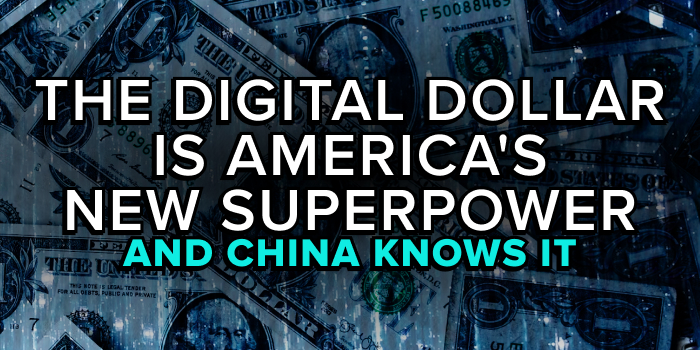The Digital Dollar Is America's New Superpower - And China Knows It

- Dollar-backed stablecoins are slipping through the cracks of China’s financial system and raising serious concerns in Beijing.
- Massive trade surpluses, shadow reserves, and growing gold purchases reveal China's efforts to maintain control.
- For investors, the rise of digital dollars could redefine how currencies, markets, and global power interact.
Money is more than just currency; it represents trust, serves as a tool for control, and acts as a measure of freedom. The cash you hold in your hand, or the digital currency on your phone, carries historical significance and reflects existing power structures.
For decades, the United States dollar has been the world's most widely used currency. It is accepted almost everywhere and serves as the primary medium for global trade. Nations hold it in reserve, and it is the standard against which value is measured. When people lose faith in their local currency, they often turn to the dollar.
Today, a new form of the dollar has emerged: digital dollar-backed stablecoins. These currencies are instant, easily transferable across borders, and create minimal friction in transactions. According to Zongyuan Zoe Liu, the Maurice R. Greenberg Senior Fellow for China Studies at the Council, China is quite concerned about these developments. This article explores her insights on the matter.
China’s dollar dilemma
China’s economy is built on trade. For years, it has run massive surpluses with the United States. That means hundreds of billions of dollars flow into China annually. In 2024 alone, the US current account deficit with China was around $260 billion.
Those dollars do not sit idle. They are invested, redirected, and recycled through China’s sovereign wealth funds, state banks, and the foreign exchange system. Institutions such as Central Huijin, CIC (China Investment Corporation), and SAFE (State Administration of Foreign Exchange) manage these flows.
This accumulation of dollars gives China influence, but it also ties the country to the dollar-based global system. When Beijing reduces its holdings of US Treasuries, it must find alternative ways to deploy the dollars. Gold purchases have risen. Currency swaps with trading partners have expanded. Offshore investment arms have been built, yet the anchor remains: the United States issues the dollar, and China does not.
The new threat
Enter stablecoins. At first glance, they appear to be merely another corner of the cryptocurrency universe. However, unlike Bitcoin, whose value fluctuates wildly, stablecoins are designed to be stable, at least in theory. Each token is backed by reserves, typically in the form of dollars. If you own one, it’s supposed to be worth one dollar, no more and no less.
That stability makes them useful. A stablecoin can be transferred instantly from one person to another, across borders, without banks, paperwork, and often without oversight. It’s programmable money, moving at the speed of the internet.
From China’s perspective, this is a threat. Stablecoins are essentially digital dollars. They bypass the gates that Beijing has built around its financial system. Exporters could be paid in stablecoins and move money abroad without approval. Citizens could sidestep restrictions and shift wealth out of the country. The centrality of the Communist Party in allocating capital would be weakened.
Control of money is control of power. Stablecoins loosen that control.
Sovereignty at stake
Every country worries about monetary sovereignty, but in China, the stakes are higher. The Party’s legitimacy is partly built on its ability to manage flows of capital and channel resources to favored industries. Capital controls are not merely economic policy; they are political infrastructure.
Dollar stablecoins cut through those controls. They provide a parallel system, one that is liquid, anonymous, and outside Beijing’s grasp. In practice, they act like digital dollar bills. Hand them over, and the government cannot easily track where they came from or where they go next.
For Chinese exporters, the appeal is obvious. Transaction costs are lower, payments are faster, and moving money offshore becomes far easier. For policymakers, it’s alarming because stablecoins not only threaten financial stability, but they also challenge the architecture of Party control.
China’s countermeasures
China is not standing still. It has been quietly reshaping how it manages its dollar exposure and promoting its own currency, the renminbi. How?
- Diversifying reserves: Chinese holdings of US Treasuries have fallen from over $1.3 trillion a decade ago to under $760 billion. At the same time, gold purchases have accelerated, creating an alternative store of value.
- Shadow reserves: SAFE and affiliated institutions deploy dollars outside official reserve statistics, funding overseas acquisitions and investments that give Beijing more flexibility.
- Renminbi push: Through currency swaps, renminbi settlement centers, and the Cross-Border Interbank Payment System (CIPS), China is trying to build the infrastructure for its own currency to be used internationally.
- Digital experiments: The digital renminbi is already in pilot programs. In Hong Kong, regulators are exploring the use of renminbi- and Hong Kong dollar-backed stablecoins within a tightly regulated framework.
Yet here lies the paradox. The features that make dollar stablecoins attractive to users, including freedom, anonymity, and liquidity, are the features China is unwilling to allow. Its digital alternatives are likely to be highly monitored, programmable, and subject to government oversight. That may appeal to institutions that need to do business with China, but it might never match the raw freedom of digital dollars.
The global stage
The stablecoin debate is not only about China. Other countries are also watching. In the past, when travelers carried US dollar bills through South America or Eastern Europe, they carried more than currency. They carried credibility. The dollar was trusted when local money was not.
Stablecoins extend that trust into the digital world. They can be used at dinner in Europe, in trade settlements in Asia, or for remittances across Africa, all without relying on traditional banking systems.
For the United States, this could actually reinforce dollar dominance at a time when some feared sanctions and geopolitics might weaken it. Stablecoins are another way for the dollar to circulate, expanding its reach even further. For China, that’s exactly the problem. Every stablecoin transaction that settles in digital dollars is a missed opportunity for the renminbi to gain ground.
What it means for investors
Why should investors care about these battles over stablecoins and reserves? Because currencies shape the environment in which every investment lives.
If the dollar grows stronger through digital forms, US assets may remain the default safe haven. If China succeeds in making the renminbi more widely used, diversification could accelerate. The value of gold, the demand for Treasuries, and the flows into emerging markets could all shift depending on how this contest unfolds.
The lesson is that monetary systems evolve. In 1971, the dollar was removed from the gold standard and became a purely fiat currency. Many thought that would doom it. Instead, it grew stronger. Today, some argue that sanctions and politics will weaken the dollar. Stablecoins suggest the opposite: that the digital future may entrench its dominance.
The paradox of control
China faces a dilemma. It wants the renminbi to be more global, but it refuses to relax capital controls. It wants to embrace digital finance, but only if it can be monitored and directed. It wants to reduce reliance on the dollar, but it still earns dollars through trade.
In that tension lies the future of global finance. Stablecoins expose the gap between what users want, such as speed, anonymity, trust, and what governments demand: control, oversight, and stability. Bridging that gap may be impossible. Time will tell.
This is based on an episode of Top Traders Unplugged, a bi-weekly podcast with the most interesting and experienced investors, economists, traders and thought leaders in the world. Sign up for our Newsletter or subscribe on your preferred podcast platform so that you don't miss out on future episodes.
Most Comprehensive Guide to the Best Investment Books of All Time

Most Comprehensive Guide to the Best Investment Books of All Time
Get the most comprehensive guide to over 500 of the BEST investment books, with insights, and learn from some of the wisest and most accomplished investors in the world. A collection of MUST READ books carefully selected for you. Get it now absolutely FREE!
Get Your FREE Guide HERE!




